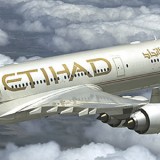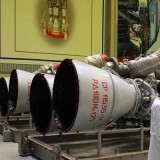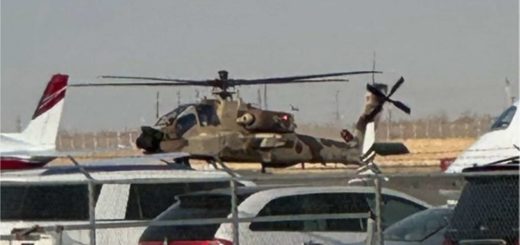Onboard the SkyLady: Comlux Aviation CEO on operating the world’s largest VIP jets

Among the aircraft on display at the latest edition of the MEBAA executive aviation show, which took place in Dubai on December 10-12, 2024, one aircraft stood out in particular: a Boeing 767 VIP called the “SkyLady”.
This aircraft is operated by Comlux, an integrated private executive aviation services firm. The company invited AeroTime onboard the “SkyLady” to take a look at one of the largest charter VIP aircraft in the world.
What’s more, welcoming us onboard was Andrea Zanetto, Chief Executive Officer of the Aviation division of the Comlux Group, with whom we had a chance to talk about the trends shaping the executive aviation industry, particularly in the Middle East.
“There is definitely a strong interest in the Middle East in general, not only in aviation. Everybody wants to be here,” he said. “After COVID, we have all seen that this is the place to be. The Middle East really has become the center of the world.”
This growth, of course, did not come out of nowhere. Zanetto explained how appetite for large executive jets in the region goes back quite a few years, even decades.
“It was a strong market and definitely growing when it comes to aircraft like the ACJ and BBJ, but this doesn’t span too far in the past. We’re talking about the end of the 1990s, early 2000s when there was a strong push to buy this type of aircraft. To have a flying apartment, rather than a flying tube,” explained Zanetto, referring to classical purpose-built business jets.
“What we see now, is that the Middle East is becoming a hub for the world, from where you can serve basically any place. There is India, Central Asia, China, Southeast Asia. These are countries that require capacity, and they don’t have enough of it.”
The executive continued to list the factors leading operators like Comlux to increase their presence in Dubai and its region.
“And of course, everybody’s looking at the Middle East as a place to be,” he added. “There is space. There’s money to invest. There are airports and even more airports to come. There is also growing interest in Saudi Arabia, because it is opening its borders and has very ambitious plans and it is also a big country with lots of oil wealth.
RELATED
MBR Aerospace Hub CEO on backing Dubai’s vision as world’s aviation capital
“[Saudi Arabia] is definitely going to follow. Maybe it’s going to take 10 years, but it is following the trend of Dubai and the Emirates in general. In a way, it is the same region, same culture, same opportunities, there are a lot of funds available, a lot of land, a lot of beautiful places as well, like the Red Sea.”
Despite not having a base in Saudi Arabia, Comlux has already been operating in the country for a number of years.
“We did have a base in Bahrain to serve our clients in the region. Flying out of Bahrain, going to Saudi to pick up passengers and then flying international because as an international airline, you can do that subject to the approval of the government,” Zanetto explained. “This is the same as we do now out of Dubai. We park the aircraft here, and then we fly to Saudi, and we take people from Saudi to the world.”
Asked about whether there will be enough of the pie for everyone in this market, given the amount of executive jet operators increasing their presence in or flocking to the Middle East, Zanetto did not appear worried. This is in great part due to the rather unique segment in which Comlux operates.
“When there’s a lot of success, everybody comes and then there could be oversupply and somebody fails. This we see all the time in the industry. It is happening somehow, and I think we, at Comlux, are the ones that have interpreted the needs of the client here with our bigger aircraft,” he said. “We have been lucky, and possibly visionary, to invest in big aircraft, more than others. Most of our fleet are VIP airliners, aircraft built as a ‘regular’ Airbus or Boeing but modified to become a VIP airliner. We are the ones that have the most experience in this field.”
Why the Middle East loves large executive jets
Zanetto then delved into how local cultural preferences make large executive aircraft a favorite among customers in the Middle East.
“For many reasons, this equipment is just perfect for the Middle East because customers here need the space. They want to travel in luxury with all the features. And when you have a big space, you can bring a lot of luggage, entourage, etc. For them, this is absolutely important because they want to travel with their own staff and want to bring back what they buy abroad.”
“This aircraft [The SkyLady], for instance, has eight tons of capacity for cargo, some 300 suitcases. We used to say we can even get a car inside,” he added. “We have also carried falcons, once more than 40 of them! This is part of the regional culture and, of course, we serve those clients.”
Comlux SkyLadyZanetto also explained how, by renting out large VIP jets on demand, Comlux achieves some synergies with other parts of its business.
“Of course, there are other firms that operate Boeing and Airbus business jets, but most of the time they operate them for private use. We make our aircraft available for charter, so we can bring clients and get our name out to show what we can do with our cabins, with our service. And then maybe one day, somebody will be interested in buying an aircraft and maybe a cabin designed and built by Comlux and then, finally, we will also operate it.”
Having the option of renting out a large jet can also appeal to certain profiles of customers, even those that may already have smaller jets.
“Heads of State of the big governments often have their aircraft. However, they may need more capacity because sometimes they fly with an entourage, [or] sometimes their aircraft is in maintenance,” he explained. “Sometimes they have extra requirements and need additional capacity. We can serve those governments.”
He continued: “We fly a lot of African governments as well. The Middle East is very well placed to serve the African countries, and not too many countries in Africa can invest in this type of equipment, so they prefer to charter, which is a very sensible approach and very efficient for them. To operate this type of aircraft, maintaining them and having the crew, etc., is a large, fixed cost. If they need to travel twice or three times per year, it’s much better to charter the aircraft.”
“It’s a good business for us,” he added. “But you must have experience in handling security, all the procedures that every government has, the protocol that you have to follow. The crew must be trained. To be capable of serving this type of market requires a lot of investment.”
RELATED
How private aviation firm Comlux takes care of the world’s largest private jets
On Comlux’s expansion in Dubai
In December 2024, Comlux officially inaugurated a new service center and hangar at Dubai Al Maktoum International Airport (DWC), strengthening its presence in the region.
“I would say we have roughly 20-30% of our fleet mainly parked in Dubai at the moment. Right now, we have 22 aircraft in total, so that’s about one third of these, although they are moving all the time,” Zanetto explained. “We believe this is the right size for business here.”
Zanetto also highlighted how the new facility will make it possible to perform certain procedures on site.
“An aircraft can be in operation for, say, 12 months without much maintenance involved, in terms of removal and installation of parts, but you must have trained people who are able to check if the systems are operational all the time. We are talking about operational checks that you do with the computer and with highly specialized tools in order to ensure that the aircraft is fit for the next flight.”
“Of course, if you do this type of maintenance in a hangar, especially when there is a harsh environment like in the Middle East, it’s much safer and it’s better for the aircraft,” he continued. “Because of the environment here, with the sun, the humidity, and the sand, if you park the aircraft in an air-conditioned hangar, it will keep its value for longer. Of course, the aircraft is designed to withstand that, but the duration of the structure, the integrity of the electrical and hydraulic systems, of everything, will reduce over time. So, having a hangar where you can park your aircraft in a conditioned environment is perfect to preserve asset value.”
“It’s like a Ferrari,” he added. “It can stay outside for 20 years, but if it’s kept in a nice, heated garage, it’s much better.”
While Comlux offers a whole array of MRO services, it is ultimately up to the aircraft owners how the aircraft is maintained, Zanetto explained.
“At the end, it is the owner who will decide whether he prefers to invest in keeping the equipment in perfect condition for 30 years or spend a bit less and park it somewhere else. And then dealing with a defect or a problem if they arise, there is nothing wrong with that. It’s just a matter of where you put your cost,” he said. “We have always performed basic line maintenance procedures on the ramp. We have purchased equipment that allows us to increase the level of line maintenance we perform in Dubai. We will save a lot of money because many of those aircraft sometimes fly to Europe just for a simple five-day check.”
Comlux Dubai Maintenance and Service Center is making the services available to other operators if an interesting business opportunity comes up.
“Of course, the goal for us is to start performing those checks and offer them not only to our customers, those that have their aircraft with us, but also to other operators. There are not too many operators here that are providing such services right now.”
RELATED
Why executive operator Comlux set up a state-of-the-art base in Dubai
The ACJ TwoTwenty program
Comlux’s flagship project, the recent launch of the ACJ TwoTwenty aircraft, the executive derivative of the Airbus A220 airliner, also came up during conversation.
“The TwoTwenty is the new thing. So far, it’s been very successful. Two units are already being operated by us, and the third one is almost ready to be delivered,” Zanetto said. “We hope that at least 50% of the aircraft we produce will be operated by Comlux. This is our target. I think that’s a good number.”
Despite the importance of the ACJ TwoTwenty program for Comlux, Zanetto was sure to mention that the firm operates a broad array of aircraft from both Airbus and Boeing.
“So, we will see the fleet of Comlux growing with the TwoTwenty but it’s not the only type we operate,” he said. “We have five A320 family aircraft. We have the A318, A319 and A320, also with the new engine type [the A320neo – ed note].
“We also have two widebodies. One of them is Comlux flagship – the 767 BBJ, the one we are sitting on right now, which we call SkyLady, and the other one, a 787, which is the most modern aircraft we have, aside from the TwoTwenty. It has ultra-modern systems and carbon fiber everywhere. We are proud to operate one.”
On the choice between the Airbus ACJ or the Boeing BBJ
Zanetto also commented on how Airbus has made inroads into the Middle Eastern executive aviation market.
“It used to be very much Boeing-oriented, but this has changed. I think Airbus was aggressive and very successful entering the airline market and when they achieved that, everybody understood that Airbus is very reliable and can fit very well into the VIP market too.
“On top of that, the A320 has two advantages over the BBJ: a larger cabin, slightly wider, which is important, and a 20-30 year more modern design, including fly-by-wire technology, which is also very important. So, if somebody is looking for something modern, the A320 is more appealing than the BBJ. The 737 is very classical.”
Nevertheless, Zanetto also had some words of praise for Boeing.
“Many like only Boeing and we love the type as well. We have performed some nice outfitting on the BBJ, even on the BBJ MAX, which we operate too. The beauty of the BBJ is its huge range capability. So, if somebody is looking for range on a VIP airliner, the BBJ can be a good choice. In general, Boeing and Airbus are head-to-head, and there are operators that have all types, like us.”
Taking care of regional preferences
Regional preferences also extend to the cabin interiors and decor, Zanetto said.
“I think the Middle East has developed its own taste, which is far from the rich and overstated cabin of some 20 years ago, very luxurious, almost baroque,” he explained, adding that it’s complex to perform maintenance on these types of cabins.
They often require a very good designer to interpret the style to fit aviation regulations, he continued.
Those regional variations, however, are being eroded by time, as aesthetic tastes seem to be converging, at least when it comes to cabin interiors.
“They went more modern, mixing a bit of classic with a more, let’s say, Western style,” Zanetto said. “In Europe and the US design tends to be very minimal, all white, which is demanding for maintenance, and maybe not that cozy as well.”
“Here people like cabins that are luxurious, but also with a lot of space and not too many monuments. They like space, open areas, where you can have a meeting for 12 people, get together and have discussions with your friends and business partners. I think that is the trend.”
Ultimately, style will be determined by the personal taste of the VIP who owns the aircraft.
“We’re also looking to work together with designers on very unique concepts. But at the end, it’s about the taste of the VIP and sometimes they don’t get together with a strong designer, they prefer a designer that follows their own views,” Zanetto explained.
The type of decor and style can also affect the market value of an aircraft, just as it would affect the value of a house or another asset with a high price tag.
“Let’s accept the fact that a very personal design is a minus because it will be very difficult to find another person that will like exactly that,” Zanetto said. “You think about your dreams, what you like, what you want, as a couple, as a person, as an investor, and you don’t think about the time when you are going to sell it. I think that is not the spirit of the design of an aircraft like this.
“Of course, the more unique the aircraft, probably the less it may be sold for. These aircraft depreciate less than the normal business jet, even if the business jets are, in fact, less customized.”
Before concluding our conversation Zanetto had time to touch upon another important aspect of the VIP flight experience which sets the large, converted VIP airliners aside from the smaller purpose-built jets – onboard service.
“The clients are similar [between different types of business jet] because they are very demanding, but with a classical business jet you have one person that does the service, and the limits of one person. But when you have such a big aircraft you can have a team, which is able to provide more sophisticated catering services to more people.”
Zanetto explained how in certain cultures, for example, the Middle East or China, having a long meal in a social setting may be far more important than, say, in a Western setting, where meals are something often quicker and merely functional. So, in terms of service, there’s a huge requirement with all the related training and coordination on the part of the crew.
“And, of course, they are very demanding clients,” Zanetto said. “They ask to be served the way and [within] the time they want. We do internal training, but our crew is also trained at one of the most prestigious hospitality schools École hôtelière de Lausanne. That is the kind of training that we have done for few years in a row in order to elevate our standards and the flying experience to the very best.” The post Onboard the SkyLady: Comlux Aviation CEO on operating the world’s largest VIP jets appeared first on AeroTime.
Among the aircraft on display at the latest edition of the MEBAA executive aviation show, which took place…
The post Onboard the SkyLady: Comlux Aviation CEO on operating the world’s largest VIP jets appeared first on AeroTime.





